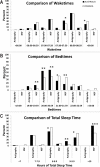Sleep/Wake Patterns and Parental Perceptions of Sleep in Children Born Preterm
- PMID: 26857057
- PMCID: PMC4865558
- DOI: 10.5664/jcsm.5802
Sleep/Wake Patterns and Parental Perceptions of Sleep in Children Born Preterm
Abstract
Study objectives: To compare sleep/wake patterns in children born preterm in Australia vs Canada and determine cultural differences in the relationship between parental perception of sleep and actual sleep behaviors.
Methods: Australian and Canadian children born preterm were recruited from the Caffeine for Apnea of Prematurity trial (n = 188, 5-12 y) and underwent 14 days actigraphy monitoring. Parents completed the National Sleep Foundation 2004 Sleep in America questionnaire. Cross-cultural differences in sleep characteristics assessed by actigraphy and parent-reported questionnaire were examined. Correlational analyses determined the associations between parental perceptions of child sleep need and sleep behavior.
Results: Actigraphy showed preterm children obtained, on average, 8 h sleep/night, one hour less than population recommendations for their age. There was no difference in total sleep time (TST) between Australian and Canadian cohorts; however, bed and wake times were earlier in Australian children. Bedtimes and TST varied by 60 minutes from night to night in both cohorts. Parent-reported child TST on the National Sleep Foundation questionnaire was 90 minutes longer than recorded by actigraphy. Both bedtime and TST on weekdays and weekends were related to parental perception of child sleep need in the Australian cohort. Only TST on weekdays was related to parental perception of child sleep need in the Canadian cohort.
Conclusions: This study suggests that short sleep duration and irregular sleep schedules are common in children born preterm. Cultural differences in the association between parental perception of child sleep need and actual sleep behaviors provide important targets for future sleep health education.
Keywords: actigraphy; cross-cultural; preterm; sleep duration; sleep patterns.
© 2016 American Academy of Sleep Medicine.
Figures

References
-
- Gruber R, Laviolette R, Deluca P, Monson E, Cornish K, Carrier J. Short sleep duration is associated with poor performance on IQ measures in healthy school-age children. Sleep Med. 2010;11:289–94. - PubMed
-
- Paavonen EJ, Raikkonen K, Lahti J, et al. Short sleep duration and behavioral symptoms of attention-deficit/hyperactivity disorder in healthy 7- to 8-year-old children. Pediatrics. 2009;123:e857–64. - PubMed
-
- Biggs SN, Lushington K, van den Heuvel CJ, Martin AJ, Kennedy JD. Inconsistent sleep schedules and daytime behavioral difficulties in school-aged children. Sleep Med. 2011;12:780–6. - PubMed
-
- Kelly Y, Kelly J, Sacker A. Changes in bedtime schedules and behavioral difficulties in 7 year old children. Pediatrics. 2013;132:e1184–93. - PubMed
Publication types
MeSH terms
Grants and funding
LinkOut - more resources
Full Text Sources
Other Literature Sources

